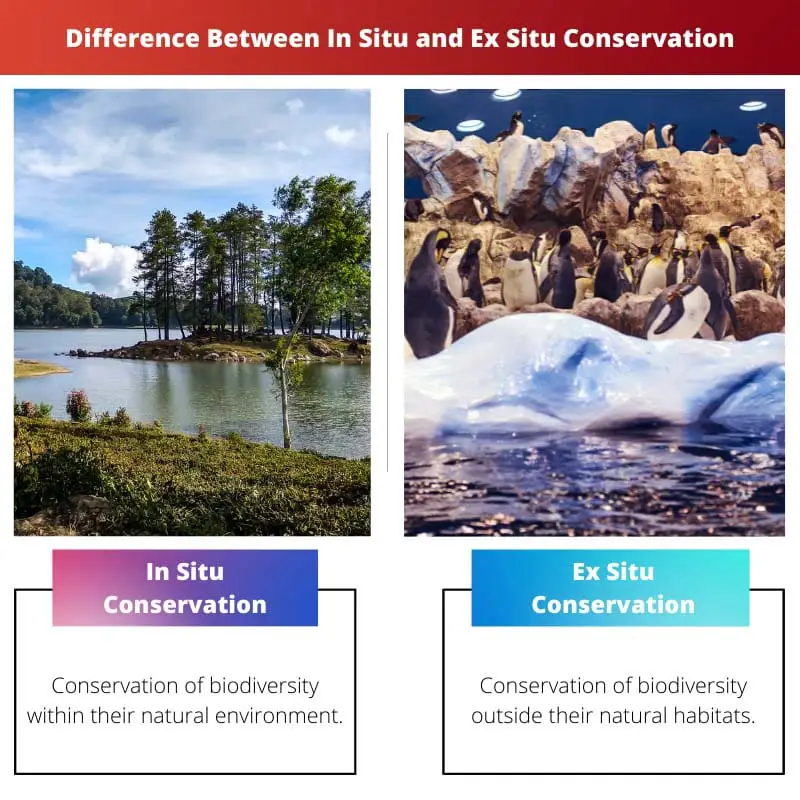In situ conservation involves the protection and preservation of species within their natural habitats, ensuring the maintenance of ecosystems and their ecological processes. Conversely, ex situ conservation involves the safeguarding of species outside their natural habitats, through measures like captive breeding programs or seed banks, aiming to mitigate risks such as habitat destruction or species extinction.
Key Takeaways
- In-situ conservation involves protecting endangered species in their natural habitats, while ex-situ conservation involves removing individuals from their habitats for protection in captivity.
- In-situ conservation helps maintain the ecological balance of natural ecosystems. It is more cost-effective, while ex-situ conservation is useful for species that cannot survive in the wild.
- In-situ conservation relies on the cooperation of local communities, while ex-situ conservation requires significant financial and technical resources.
In Situ vs. Ex Situ Conservation
In Situ, conservation refers to the safeguarding or caretaking of species living inside their natural habitat. Ex situ conservation protects species living outside their natural habitat and environment. This type of conservation is good for species that are becoming extinct.

Comparison Table
| Characteristic | In Situ Conservation | Ex Situ Conservation |
|---|---|---|
| Definition | Protecting endangered species in their natural habitats | Protecting endangered species outside their natural habitats |
| Location | Within ecosystems where the species naturally occur | In controlled artificial environments (zoos, botanical gardens, seed banks, etc.) |
| Advantages | * Maintains natural ecosystems and evolutionary processes* | * Offers higher levels of protection from immediate threats* <br> * Facilitates research and breeding programs* |
| Disadvantages | * Vulnerable to habitat destruction and external threats* | * Can be expensive to maintain* <br> * May not replicate the complexities of natural habitats* |
| Examples | * National parks and wildlife sanctuaries* | * Zoos, aquariums, and botanical gardens* <br> * Seed banks and gene banks* |
| Best Suited For | Species with large habitat requirements <br> or those heavily impacted by human activity | Species facing immediate extinction threats or requiring specialized care |
What is In Situ Conservation?
In situ conservation refers to the preservation of ecosystems, natural habitats, and species within their native environments. This approach aims to maintain biodiversity where it naturally occurs, protecting the complex interactions between organisms and their surroundings. In situ conservation strategies prioritize the conservation of entire ecosystems or landscapes, recognizing the interconnectedness of species and the environment.
Objectives of In Situ Conservation
- Preservation of Genetic Diversity: By conserving species in their natural habitats, in situ conservation helps safeguard the genetic diversity essential for adaptation and evolutionary processes.
- Protection of Ecosystem Functions: In situ conservation maintains intact ecosystems, ensuring the continuation of vital ecological processes such as nutrient cycling, pollination, and water regulation.
- Promotion of Species Interactions: By allowing species to interact naturally within their ecosystems, in situ conservation supports symbiotic relationships, predator-prey dynamics, and other ecological interactions crucial for ecosystem stability.
- Maintaining Cultural and Socioeconomic Values: Many indigenous communities and local cultures rely on intact ecosystems for their livelihoods, cultural practices, and traditional knowledge. In situ conservation respects and supports these cultural connections to the land.
Strategies of In Situ Conservation
- Protected Areas: Establishing protected areas such as national parks, wildlife reserves, and marine sanctuaries is a key strategy for in situ conservation. These areas are legally designated for the conservation of biodiversity and restrict human activities that could harm natural ecosystems.
- Habitat Restoration: Restoring degraded habitats to their original conditions is another important in situ conservation strategy. This may involve removing invasive species, replanting native vegetation, or reintroducing species that have been locally extirpated.
- Community-Based Conservation: Engaging local communities in conservation efforts can enhance the effectiveness and sustainability of in situ conservation initiatives. Community-based approaches empower local stakeholders to participate in decision-making processes and contribute traditional ecological knowledge.
- Sustainable Land Management: Encouraging sustainable land management practices, such as agroforestry, organic farming, and sustainable forestry, can help conserve biodiversity while supporting human livelihoods.
- Corridor Conservation: Creating wildlife corridors or ecological corridors connects fragmented habitats, allowing species to migrate and disperse more freely. This strategy helps prevent genetic isolation and enhances the resilience of ecosystems to environmental changes.

What is Ex Situ Conservation?
Ex situ conservation involves the preservation of genetic resources, species, or entire ecosystems outside of their natural habitats. This approach is employed when in situ conservation measures are insufficient to ensure the survival of threatened species or when species need intensive management or breeding programs to prevent extinction.
Objectives of Ex Situ Conservation
- Genetic Diversity Preservation: Ex situ conservation aims to maintain the genetic diversity of species by preserving individuals in controlled environments. This genetic diversity is essential for species’ long-term survival and adaptation to changing environmental conditions.
- Species Recovery and Reintroduction: Ex situ conservation provides a safety net for endangered species by allowing for captive breeding, habitat restoration, and reintroduction programs. These efforts help bolster wild populations and restore ecosystem functioning.
- Research and Education: Conservation facilities engaged in ex situ conservation serve as research centers, where scientists study species biology, behavior, and genetics. Additionally, these facilities play a crucial role in educating the public about biodiversity conservation and the importance of preserving endangered species.
- Insurance against Catastrophic Events: By maintaining populations of endangered species outside of their natural habitats, ex situ conservation reduces the risk of extinction due to catastrophic events such as natural disasters, disease outbreaks, or habitat destruction.
Strategies of Ex Situ Conservation
- Botanical Gardens and Arboreta: Botanical gardens and arboreta maintain living collections of plants for conservation, research, and education purposes. These institutions focus on rare and endangered plant species, providing a safe haven for threatened flora.
- Zoos and Aquariums: Zoological parks and aquariums play a critical role in ex situ conservation by housing and breeding endangered animal species. Many zoos participate in species survival plans (SSPs) and captive breeding programs aimed at reintroducing animals into their natural habitats.
- Seed Banks and Gene Banks: Seed banks and gene banks store seeds, tissues, or genetic material from a wide range of plant species. These repositories serve as a backup in case of catastrophic events or for future use in plant breeding programs.
- Captive Breeding Programs: Captive breeding programs involve breeding endangered animals in controlled environments to increase population numbers and genetic diversity. These programs collaborate with zoos, wildlife reserves, and research institutions to reintroduce animals into the wild.
- Cryo-preservation: Cryo-preservation, or the freezing of biological materials at extremely low temperatures, is used to preserve genetic material such as sperm, eggs, or embryos. This technique is valuable for maintaining genetic diversity and facilitating assisted reproduction techniques in endangered species.

Main Differences Between In-Situ and Ex-Situ Conservation
- Location:
- In situ conservation occurs within the natural habitats of species.
- Ex situ conservation takes place outside of the natural habitats, in controlled environments.
- Approach:
- In situ conservation focuses on preserving entire ecosystems, habitats, and species within their natural environments.
- Ex situ conservation involves the preservation of genetic resources, species, or ecosystems outside of their natural habitats.
- Scope:
- In situ conservation addresses the root causes of biodiversity loss by protecting natural habitats and ecosystem processes.
- Ex situ conservation provides a safety net for endangered species and genetic diversity, through captive breeding, seed banks, or botanical gardens.
- Impact:
- In situ conservation aims to maintain ecosystem functions, support species interactions, and conserve biodiversity where it naturally occurs.
- Ex situ conservation helps mitigate the risk of extinction for endangered species, facilitates research and education, and provides genetic resources for future conservation efforts.
- Examples:
- In situ conservation strategies include protected areas, habitat restoration, community-based conservation, and sustainable land management.
- Ex situ conservation methods include zoos, botanical gardens, seed banks, gene banks, and captive breeding programs.
- Long-Term Goals:
- In situ conservation aims to ensure the long-term viability and resilience of natural ecosystems and the species they support.
- Ex situ conservation seeks to prevent extinction, recover endangered species populations, and preserve genetic diversity for future generations.




